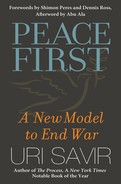CHAPTER SIX
Creative Diplomacy
FEW POLITICAL ACTIVITIES ARE SO MISUNDERSTOOD AND underestimated as diplomacy. It is often seen as a behavioral pattern rather than the pursuit of national interests and peace. Calling a person “diplomatic” has come to be almost an insult—it is parochially perceived, at best, as not being candid and, at worst, as being deceitful. Diplomats themselves have often misinterpreted its real usefulness. As the author Daniele Vare said, “Diplomacy is the art of letting someone have your way.”
But one-sided solutions merely provoke the losing side to want to overturn the situation. Creative diplomacy invites us to view compromise as a positive opportunity rather than a potential loss. By concentrating on innovating solutions that emphasize how both sides will gain, we can tackle complicated problems with flexibility and mutual respect.
If militant methods are the heart of warmaking, then creative diplomacy must be the heart of peacemaking. In war, diplomacy serves the interests of the war effort. In peace, security must be geared toward peacemaking and maneuvered by diplomacy. Too often, peacemakers treat security as a means to achieve peace, but it should be the other way around. Only peace can achieve security. Security must be perceived in its broadest and most comprehensive sense; it should not simply be highlighted as a bone of contention but should provide citizens with a feeling of safety in the long run. Through creative diplomacy, peacemakers can steer the security situation toward guaranteed calm, employing security steps such as demilitarization, security coordination, weapons control, and external monitoring to prevent a new flare-up. 78
Creative diplomacy aims to explore and express common interests that can evolve into practical peacebuilding projects. Creativity should not result in unrealistic promises; diplomatic activity must always be realistic and accountable. This kind of creativity relies on leadership. As Sir John Hoskyns put it, “Strategic leadership requires … a readiness to look personally foolish; a readiness to discuss half-baked ideas, since most fully baked ideas start out in that form.”1 Leaders that are appropriate to peace diplomacy possess a character that is generous, magnanimous, forgiving, and uncompromising when it comes to basic humanitarian values. Creative diplomacy implemented by the right leaders is a bridge to peace in all its facets.
I have been party to many small-scale efforts at creative diplomacy. For example, in July 1994 Israelis and Palestinians negotiated a historic agreement to transfer parts of the West Bank territory and authority to the Palestinians. The agreement also implied the first free and fair election of the Palestinian Authority’s chairman and parliament.
Every detail of these elections was negotiated, including the participation of Palestinians living in East Jerusalem, which was the most contentious issue at the time. Under the agreement, Jerusalem would not fall under the Palestinian Authority’s jurisdiction of the West Bank and Gaza. However, we took into consideration that under no circumstances would Arafat and his team hold elections without East Jerusalemites being eligible to vote.
Although we understood the nature of their predicament, the Israeli delegation was opposed to holding elections in East Jerusalem in the same manner as they were going to be held in the West Bank and Gaza, because the elections could affect the city’s status in a similar way.
My Palestinian counterpart Abu Ala and I knew that we alone could not resolve this issue and that there would be repercussions regarding the future status of Jerusalem. Together with Chairman Arafat and Foreign Minister Peres, we were invited to Cairo by 79 Egyptian President Hosni Mubarak to be part of a very creative exercise in diplomacy.
The Israeli side favored the idea that East Jerusalemite Palestinians would vote like Palestinians abroad—through an absentee ballot. However, the Palestinians wanted to mirror election practices in the West Bank and Gaza by setting up voting stations. After intense backroom discussions, President Mubarak thought up a most creative solution to our problem. Polling stations would be set up inside East Jerusalem post offices for the duration of the election. Israelis could claim the Palestinians were sending their votes by mail as absentee ballots, whereas the Palestinians could assert that East Jerusalemites were voting in regular polling stations that happened to be at post offices. All that was left was a creative design that reconciled a post box and a polling booth—an easy hurdle once everyone was on board.
In the end, both sides got what they wanted without having to sacrifice their fundamental needs and ideals. Granted, many challenges of modern peacemaking are more complicated than casting ballots. But if we approach these contentions with creative diplomacy in mind, we can frame compromises as gains for all.
The decision to make peace is not enough to prevent devastating war. Peacemaking efforts must address the core beliefs and activities of society and its leaders. This new peace architecture rests on the four pillars: participatory peace and glocalization, peace ecology, peacebuilding, and creative diplomacy.
But how do we create this structure? What are the steps to creating a “modern” peace? This is the subject of part 3.
